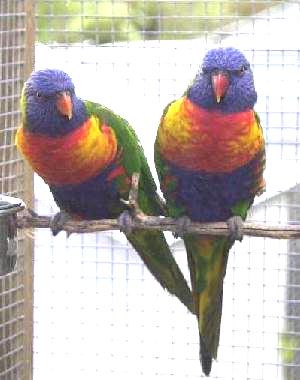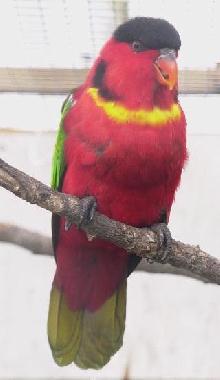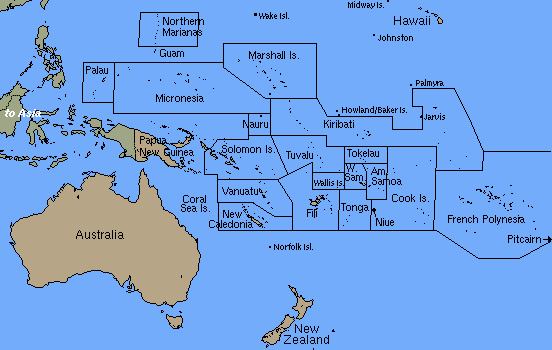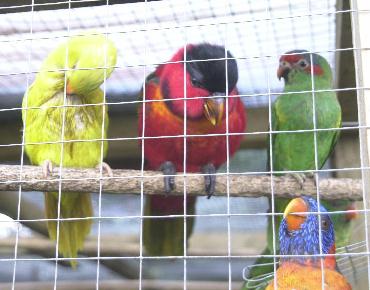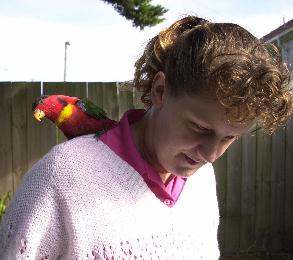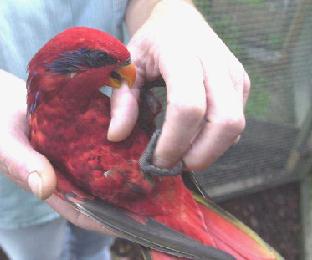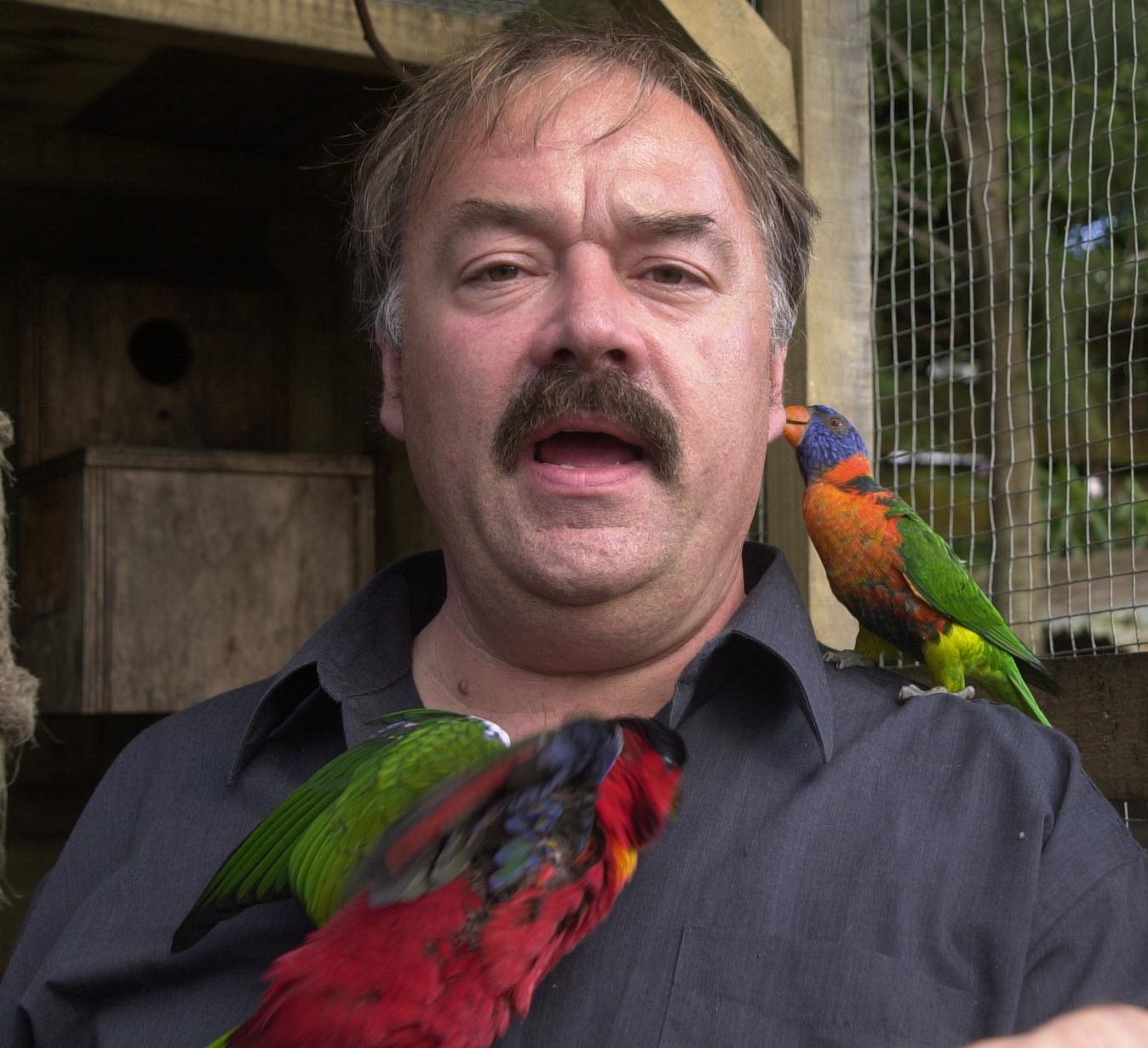What are Lories and Lorikeets?
Lories and lorikeets are birds of the Parrot family, subfamily Loriinae.
They are medium sized
parrots with an average size of 22 to 33 centimetres and weigh from 70 to 200
grams. They have a life span usually in the range of 25 to 35 years with many
living to over forty years and are some of the most beautiful birds in the world
with brightly coloured attractive plumage. They are a very intelligent species
of parrot with many learning to talk and mimic many sounds, and they have been
called the clowns of the parrot world because of their outgoing friendly
personality, gregarious and inquisitive nature.
Also known as brushed-tongued parrots, lories and lorikeets are nectarivorous
(nectar eating) birds feeding mainly on pollen, nectar and fruit juices.
It is this that makes them different from most other parrots that are seed
eaters.
They have a specially designed tongue with a brush like end
(actually papillae covering the end portion of the tongue)
to make collecting their food easier, as they need to reach right into flowers
to get to pollen and nectar.
There are no lories or lorikeets that are native to New Zealand, all have been
imported at some time. There are currently no bird (avian) imports allowed into
New Zealand, we can export but not import.
A Native New Zealand bird, the Tui, also is nectarivorous although this is
not a parrot.
What is the difference between a Lory and a Lorikeet?
The main difference is simply in the length and shape of their tails.
A lorikeet, for example the Rainbow lorikeets pictured below left, have long
thin tails, whereas a lory, for example the Yellow-bibbed lory pictured below
right, has a wider shorter tail.
The names Lory and Lorikeet are often used to mean both types of bird and,
for example, in Australia, all are usually referred to as Lorikeets.
As different people have contributed to this web site the names are often
used to mean both types, most often all are called lories.
Note the brightly coloured plumage of these birds, this is one of their main
attractions to many people.
Rainbow lorikeets. |
Yellow-bibbed lory. |
Where do Lories and Lorikeets come from?
They are a tropical bird able to withstand a wide range of temperature
variation coming from many tropical parts of the world but mostly from New
Guinea, Indonesia, Australia and various islands in the South Pacific.
The Oceania map below shows the area that 53 known lories and lorikeets
originate from (note: none from New Zealand)
Below is a list of the known lories and lorikeets and where
each originates - refer to the Oceania map above.
Note that some have
articles and photographs available via links to other web locations
Lories and Lorikeets
Black Capped lory - New Guinea
Black Winged lory - Indonesia
Blue-streaked lory
- Indonesia
Cardinal lory - Solomon Islands
Chattering lory
and
Yellow-backed lory
- Indonesia Northern Moluccas Islands
Duyvenbode's lory - Northern New Guinea
Edwards lorikeet
- Indonesia - Timor Island
Emerald lorikeet
- Irian Jaya and central mountain borders of Papua New Guinea.
Fairy lorikeet- New Guinea in the mountainous areas
Dusky lory
- New Guinea
Forsten's lorikeet - Indonesia Sumbawa Islands
Red lory (also known as Moluccan lory) Indonesia
Goldie's lorikeet
- New Guinea central mountainous part from Weyland Mountains to South Eastern Papua New Guinea.
Green Naped lorikeet - New Guinea and the Indonesia islands
Iris lorikeet - Indonesia Timor and Wetar Islands
Josephine's lorikeets - New Guinea
Little lorikeet
- Eastern and South-eastern Australia from North Queensland to South Australia sometimes reaching to North-East Tasmania.
Massenna's lorikeet
- Solomon Islands - New Guinea - New Hebrides - Archipelago
Meyer's lorikeet - Indonesia
Mitchell's lorikeet - Indonesia Islands of Bali
Musk lorikeet
Musk lorikeet - East and South-east Australia to South Australia Spencer Gulf Region. Also In Tasmania eastern half. Becoming very popular in New Zealand aviaries, make great pets if handreared. Colour mutations can include olive & mustard
Musschenbroek's lorikeet - Mountainous areas of Central New Guinea.
Obi Violet-Necked lory - Indonesia
Ornate lorikeet- Indonesia
Perfect lorikeet - Indonesia
Purple Bellied lory - South East New Guinea
Purple-crowned lorikeet
- Extreme Southern Australia to as far north as southern Queensland.
Purple Capped lory - Indonesia - Ceram
Rajah lory - Western New Guinea
Red-collared lorikeet
- Northern Australia from Kimberley division of Western Australia east to Queensland. Mutations can include Olive - ( grey/green)
Red Spotted lorikeet - North West New Guinea - Indonesia in the Islands of Biak.
Rosenburg's lorikeet - Indonesia the island of Biak
Scaly-breasted
- North Eastern Australia. Very affordable to the
pocket makes a great pet. Colour mutations can include normal green, olive -
(grey/green)
cinnamon
, yellow, mustard and lutino.
Stella's lorikeet - New Guinea This is one lorikeet specie where the male or female can be a black in colour called melanism or Red in colour . The female is distinguished by her red flanks.
Striated lorikeet - Western New Guniea.
Swainsons lorikeet
- (also known as the Blue Mountain or Rainbow lorikeet) Eastern Australia from Cape York Peninsula South to Tasmania and Kangaroo Island also introduced to the Perth area, Western Australia. Very Common in NZ refer to the article section "Rainbow lorikeet saga in New Zealand" giving different objectives on the so called problem we have here in New Zealand. Mutations can include Olive (grey/green) and Lutino.
another link about Rainbows -
Burkes back Yard
Tahiti Blue lory- Pacific rim Society Islands - Cook Islands. Very rare in Agriculture
Ultramarine lory
- If I had one wish this is what I would wish for. Weighs in at 35 grams. Are special treasure of nature. Feathers are pale blue, dark blue, fluro blue and white. Very very rare.
Varied lorikeet- Western and Northern Australia common in wooded country especially like to be near water.
Violet Necked lory - Indonesia
Weber's lorikeet- Indonesia Timor Islands
Wilhelmina's lorikeet - Central Highlands of New Guniea (This is one of the smallest lorikeets weighing in at only 20grams they are very rare.
Yellow-bibbed lory
- Solomon Islands
Yellow Streaked lory - Southern New Guinea Aru Islands.
What Lories and Lorikeets are available in New Zealand?
Recently several Lory-Link members asked this very question to try and
establish what we had as breeding stock in New Zealand. Since no avian
imports have been allowed into New Zealand for the last number of years and it
appears this situation will not change for the forseeable future, it is highly
unlikely we will see any new varieties of lory or lorikeet for some time
into the future (notwithstanding illegal imports). The present silly attitude
that the government (Dept of Conservation) has concerning Rainbow lorikeets
makes the likelihood of parrot imports in the future even more remote.
Furthermore it appears that there is a very limited number of lory breeders
and breeding pairs of lories in New Zealand. It is estimated the number of
breeders is between 25 and 35 and actual breeding pairs of lories is no
more than 150. The total population of captive lories is thought to be no more
than two to three thousand with any wild populations being insignificant.
The results of enquiries and reviewing the availability of lories and lorikeets
from breeders provided the following list (excludes lories in zoos although
no other varieties outside the list below are known to be in their collections)
|
Rainbow lorikeet, well established, Olive variety less common but available |
Yellow Scaly, Yellow-bibbed, |
The following may exist in New Zealand but are unconfirmed and none have been
made available for sale.
Dusky lory
Chattering lory (not the Yellow-backed lory - see list above)
Little lorikeet
Violet-necked lory
Red lory
Although the Red-collared and Musk lorikeet olive mutations (or more correctly
Grey-Green mutation), are fairly common in Australia they are relatively
unknown in New Zealand. Several NZ breeders are currently working to establish
these mutations.
Scaly lorikeet yellow (dilute), lutino and cinnamon mutations along with
Rainbow
lorikeet Grey-green (Olive) mutations have been available for some time but
are still reasonably rare as they have never become well established.
Almost all of the new colourful mutations of lorikeets recently developed in
Australia are still non-existant in New Zealand. One local breeder is known
to be trying to produce the lutino Rainbow lorikeet, so far without success.
From this list it can be seen there is a pitiful small variety of lories
and lorikeets available in New Zealand. The Australian types are most
common and most easily available and others, apart from the Yellow-bibbed
non-Australian lory, are just not established in any meaningful numbers.
With such a few breeding stock for these less common lories and no imports
of new blood for the forseeable future it may not be possible to establish
these in New Zealand. This applies more so to the rarest examples, Black-capped
lory, Edwards lorikeet and perhaps the Chattering lory (One breeder at the
2001 Down Under Parrot conference held in June 2001, Auckland, NZ, insists
that Chattering lories do not exist in NZ and that all birds so identified
are actually Yellow-backed lories - a pair obtained in mid 2001 described as
Chattering lories were in fact the Yellow-backed variety).
A recent outbreak of PBFD (Psittacine Beak and Feather Disease) in mid to
late 2000 took out some breeding pairs of less well established lories
with at least four breeding pairs of Blue-streaks being lost. Others
affected by this outbreak included Yellow-bibbed lories, Musk, Rainbow and
Scaly lorikeets, in all several dozen birds were lost although the actual
number could be much higher since some breeders did not want to disclose
they experienced PBFD problems.
All of the well established types are normally available from pet stores
or can be easily obtained from local breeders. Rainbow lorikeets are by far
the most popular and most pet stores will easily be able to source these.
Close behind in popularity is the Scaly lorikeet and then the Musk lorikeet.
These three types seem to available all year and can be obtained without too
much difficulty.
Red-collared lorikeets and Yellow-bibbed lories are more difficult to obtain,
they seldom appear in pet stores, but breeders almost always have young birds
available. Pairs of Yellow-bibs are near impossible to find, but
quite often Red-collars are sold as young pairs.
There has been some difficulty in sourcing Yellow-bibbed lory cock birds
for the last two years (maybe longer) as all available young birds are hens.
It is not
known why this situation has arisen (are all cocks being exported?) but it
is still an ongoing problem for those wanting to acquire a pair.
The situation with Red-collars is improving while they maintain a good sale
value and since they can start breeding at about two years old there are
more breeding pairs starting every year. There appears to be more young birds
becoming avialbale for sale locally.
Although there are quite a few pairs of Yellow-bibs with breeders, it seems
very few are actually successfully breeding. Pairs generally do not start to
breed until three to four years old. There is also a well known egg breaking
problem with boisterous cock birds that can delay and reduce the success of
producing young Yellow-bibs.
The situation with Blue-streaked lories looked promising in 1999/2000 as
a dozen or so birds were made available for sale and at least three breeders
obtained unrelated pairs of young birds from these. It will
probably be 2003 before any new Blue-streaks are bred from them.
Of five proven breeding pairs known in 1999, four of these plus at least six
young birds were lost to a PBFD outbreak in mid to late 2000. It appears that
no Blue-streaks were made available for sale in 2001 although it is hoped
this situation will change in 2002/2003.
Those of unknown or few-in-number status will generally only be available from
one or two breeders in New Zealand. Even then it may not be possible to
purchase birds as more than a few breeders prefer not to provide potential
breeding stock to other breeders or people who could become lory breeders.
This action results in many young birds being exported from New Zealand and
reduces even further the chances of less common lories becoming established in
New Zealand. It also keeps the selling price of such birds quite high because
of their rarity. A similar situation occurs with uncommon mutations of
well established types and again breeders seem to prefer exporting instead
of selling within New Zealand.
A quick poll of about twenty breeders with breeding pairs of red-collared
lorikeets shows that over 66% of all young birds produced in the year 2001
were exported. An estimate of the total young red-collars produced in 2001
in New Zealand is 72.
Of all the pet shops/stores in the Auckland area of New Zealand that sold
lorikeets in 2001 it appears that only six red-collars were made available to
them for sale. At least a further twenty were offered for sale privately.
In 2002 there appears to be no more than six breeders in New Zealand with
Yellow-bibbed lories that actually produce young birds. There are at least
another ten breeders with pairs that are not yet breeding. An estimate of the
number of young birds made available for sale in 2001 is twelve. Midway
through 2002 and only six young yellow-bibs have been available for sale.
It is believed that no yellow-bibs were exported in 2001/2 and there may
have been no exports as far back as 1996.
The total New Zealand population of Yellow-bibs is thought to be no more than
eighty and is probably closer to sixty. At least ten yellow bibs were
lost in a PBFD outbreak in late 2000, including several breeding pairs.
By early 2004 the situation with Red-collars has greatly improved and these are now quite common and easy to obtain. Many are exported from New Zealand. Anothertype of Rainbow, the Massenas lorikeet is also becoming available although it
is still not very common. There are still almost none of the rarer breeds
available such as Yellow-backed chattering lories, Blue-streaks, Dusky,
Cardinal, and Red lories. Very few Yellow-bibs have been available.
If you live in New Zealand and are aware of other types of lories resident here either as pets or breeding pairs perhaps with young birds available or coming available then please let us know (see CONTACT below). We would like to try and keep the information on availability and status of lories in New Zealand up to date.
What do Lories and Lorikeets eat?
In the wild they feed on the pollen and nectar produced by flowering trees, shrubs and fruit trees.
lorikeets also like to eat fruit such as apples and pears and this is a
main part of there diet especially in captivity along with special wet mix
recipes to replace the pollen and nectar they would normally collect and eat
in the wild.
Unlike many other parrots, lories and lorikeets cannot be fed on a seed based e
diet. They do occasionally enjoy soaked seeds and will crunch the seeds they
find in fruit but their digestive system is incapable of handling a mostly
seed diet since it is designed to deal with liquid nectar and juice they
obtain from crushing flowers and fruit.
For more detail on feeding lories and recipes for wet-mixes (nectar
replacements) and dry-mixes (pollen replacements), along with information on
suitable fruits and vegetables look at the
 area on this web site.
area on this web site.
Do they make good pets?
Lories and lorikeets make excellent pets although there are some factors that
need to be taken into account when making a decision to get one for a pet.
A lory will tend to bond to one human and this adoption of a human is a
main attraction for some lory owners. If the lory is obtained while still
quite young then this bonding occurs quite quickly. An older lory may take
some time to trust a particular human but will nearly always select its
owner to bond to. Hand raised baby lories are the easiest to work with since
they will already be familiar with being handled and will have built up a
trust with humans.
A new lory will always be quite shy and until it becomes familiar with its
new home, humans and surrroundings it will tend to be quiet (reasonably!) and
shy away from most people. If it does bond quickly to its owner and it is
a young bird then it may give the impression of trying to hide or thats its
afraid and is trying to get as close as possible by geting under hair or
clothing on its human. It will eventually grow out of this behaviour but will
still look forward to and enjoy play with and being on its human.
A lory loves to perch on it's human's shoulder, play nibble at ears, eyebrows,
get in behind hair, preen hair, remove and play with glasses/sunglasses, play
with jewellry on ears and hairbands, and sometimes just go asleep perched on
a shoulder.
Since lories are quite intelligent birds they need almost constant stimulation
to prevent boredom. A bored lory can become quite miserable and this can result
in behavioural problems which can include biting humans, plucking its
own feathers, refusing to eat or other strange behaviour.
The best companion for a lory is another lory as they will play together
and seldom will one become bored. But where it is impractical to have two or
more birds then the lone bird will need lots of attention and time spent
playing with its human. Toys in the cage or aviary will help and everything
from lots of perches, hanging ropes and chains, swings, laddders, balls,
beads and noise making devices will provide hours of pleasure for the lory.
Perhaps the one major negative point for most potential owners of a lory is
the fact that as nectar eaters the poop from a lory is liquid and it can be
squirted some distance. This can make a mess of the area
surrounding a cage or indoor aviary and some measures need to be taken to
contain this mess. This can mean placing some sort of screening material
around the lower half of a cage or in more expensive cages the use of clear
acrylic sheeting or glass around most of the lower cage.
In an outdoor aviary this is not so much of an issue as with other non
nectar eaters a good hosedown of the avairy floor is the best way to keep it
clean.
Yellow-bib with pet human Kellie |
Blue-streak enjoying a tickle |
Yeooh! Red-collar nips an ear |
What sort of cage or aviary do I need?
Basially one large enough for the lory to live and sleep in comfortably.
A cage is usually for indoors although an outdoor aviary is a much better idea
since it will mean the calls or noises of the lory do not become an annoyance
when the lory is demanding attention.
An aviary large enough to allow the lory to fly around is the ideal solution
but such an aviary would need to be at least 5 metres long by 1.2 meetres wide
and 1 metre high. Such a large structure may not be possible where space is
limited. An alterative is to keep the lory in a smaller space but allow it
some time to fly around a room or garage.
For more general information on cages, aviaries, nestboxes and their design
refer to the
 area on this web site.
area on this web site.
Where do I get a Lory or Lorikeet and how much do they cost?
The best source is from a lory and lorikeet breeder although many pet
stores will know how to source a lory for a customer. Larger pet stores will
often have one or more different breeds of lory and lorikeet available.
Also look in the
 area on this web site.
area on this web site.
The most popular and low priced lorikeets tend to be Rainbows, Musks and
Scalies. These are all Australian lorikeets and the rainbow is well
known for its striking coloured plumage which immediately appeals to the
potential lorikeet owner.
Most of these more common lories will be hand-reared but it may be a good idea to confirm this
with the seller as an aviary raised bird will definitely not be as human
friendly and will take a lot longer to become a trusting pet. If you are
after a bird for breeding purposes then the aviary raised bird will tend
to bond to another bird and start breeding much sooner than a pet bird.
Pets that eventually pair off for breeding will become more protective of
each other and their nesting box and less dependant on humans for
companionship. (i.e. they may become more nippy!)
For the more expensive and less common Lories then doing some research on
possible sources is the only answer. Joining a local parrot club or society
is a good first move and if the required bird is available locally or there
is a breeder nearby then the club will often know about it. Quite often
the for-sale sections of their newletter or magazine will be a good
source for contacting people even if the bird you want is not advertised.
Again with these less common birds most will have been hand raised. Breeders
will probably have removed either the eggs to eliminate any risk of breaking
fertile eggs, or the young birds to avoid possible feather plucking or
feeding problems of young birds.
If the bird is to be a pet then again check with the breeder that it has been
hand raised.
In general the selling price of Lories in New Zealand is higher than in many
other countries. This is a reflection on the relatively few breeders in
New Zealand and the small population of breeding lories.
Pricing varies depending on immediate availabilty, recent sales both from
pet stores and from Breeders suggests the following prices for single birds,
pairs (cock and hen), and mutations in New Zealand dollars:
Rainbow lorikeet $250 to $300, $900/olive, Pair greens $500 to $600,
Massena's lorikeet $500 to $600, pair $1000 to $1200,
Red-collared lorikeet $500 to $600, Pair $1000 to $1200,
Musk lorikeet $200 to $300, Pair $500 to $700, more for Yellow Pied mutations,
Scaly lorikeet $180/green $200/olive $900/yellow up to $2000/cinnamon, Pair
$350 to several thousands, green/yellow and green/cinnamon split males to $500
Yellow-bibbed lory $1500+, Pair $3000+, breeding Pair $3500+,
Green-naped lorikeet $2000/pair
Blue-streaked lory $2000, pair $4000+, breeding Pair $5000+
Yellow-backed lory $2500, pair $5500+
Cardinal lory $3000, pair $6500+
Note that a breeding pair will often cost more than the 'pair' prices
indicated above. This is the difference between a bonded pair, which will
often mean birds that may be old enough to breed but may not actually have
produced fertile eggs and an established breeding pair that have successfully
raised young (or from which young have been successfully hand-raised by
humans!).
Other factors affecting prices include:
Is the bird DNA sexed? and is there documentation showing this? (unlikely with lower cost lories)
Is the bird guaranteed PBFD free? and free from other virus infections?
Is the bird hand reared? if so is it a young bird?
Is there any return or exchange possible if bird is not suitable?
Who pays for shipping and insurance if bird is to be sent via shipper/courier?
and related to this who is responsible if the bird does not arrive safely?
Is a cage, aviary, nestbox, toys, etc., included in the price?
Is any support material/documentation provided? ie feeding information or
food samples?
Obviously the more unusal birds will attract a much higher price with mutations
being particularly high priced.
It is also unusual for an established breeding pair of birds to be commonly
available and nearly all pairs will be young birds, probably no more than one
year old. If purchased for breeding then be prepared for a two to three year
wait
for larger birds to start breeding. Smaller birds such as Musks and Scalies
have been know to start breeding from as young as six months although two
years appears to be the usual age.
Contact us
If you have a question or enquiry about Lories then leave a message in
the message forum on this web site. Please remember to include your email
address. If you would like to email
the Lory-Link please send email to Kellie Stewart
(arawa.aviaries@xtra.co.nz)
If you are in New Zealand and would like to find out more about meetings and
subscribing to the Lory-Link newsletter then you can phone Kellie on
AUCKLAND (9) 827-3604 or Fax AUCKLAND (9) 358-0059.

|
Page written by David Dix, last modified 15 May 2004.

